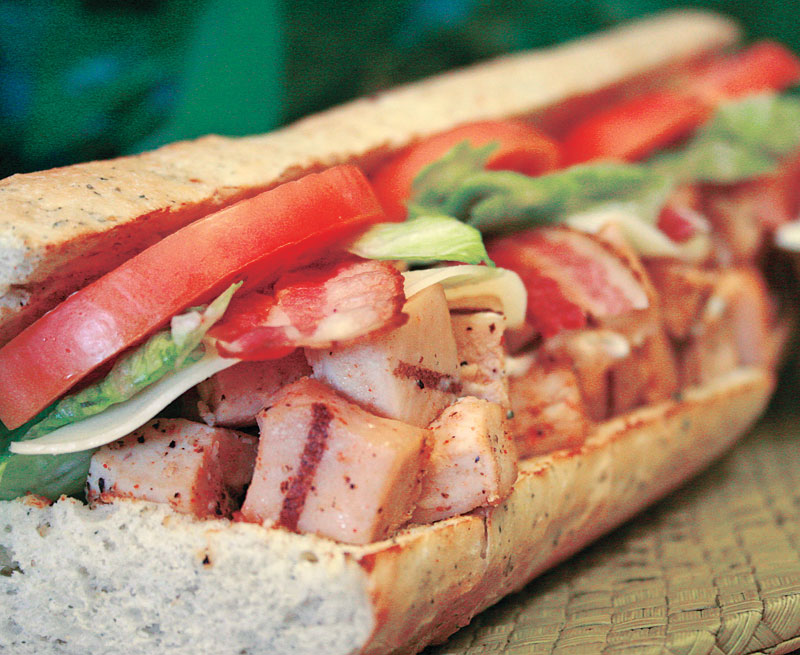Let’s just go ahead and put it out there: Cheba Hut is a hippie’s dream concept. Everything from menu items and sizes of sandwiches are described using what management refers to as “counter-culture” lingo.
“We have a group of core customers who not only get the references, but who we are making a fundamental connection with,” says Matt Trethewey, chief operating officer of Cheba Hut Franchising Inc. “What’s surprising to most people, however, is that our overall customer base is very diverse. Through our food and our service model, people come back.”
Trethewey says it may take some customers a while to get the innuendo at Cheba Hut. But eventually, “we’ll see that moment of awareness on their faces,” he says.
Cheba Hut’s first location opened in 1998 in Tempe, Arizona, near Arizona State University. The concept slowly spread to other college towns over the years and now has 14 locations in Arizona, Colorado, Iowa, New Mexico, California, and Oregon. Trethewey says there will be two new stores open by the end of October in Madison, Wisconsin, and Flagstaff, Arizona, and there are agreements in place for four additional locations.
Cheba Hut Toasted Subs
President: Scott Jennings
HQ: Tempe, Arizona
Year Started: 1998
Annual Sales: $10 million
Total Units: 14
Franchise units: 14
“When that first store opened, franchise wasn’t in Scott’s vocabulary,” Trethewey says of the brand’s founder, Scott Jennings. “He was one guy who wanted to own a mom and pop shop.” Despite that intention, the chain began growing slowly. Between 2002 and 2007, Jennings would open new stores one at a time and transfer them to new operators.
“He kept opening and operating stores individually until someone came around to transfer them to,” Trethewey says. “Then, in 2007, Scott and I met and started working together. In 2008, we started to grow through franchising.”
The idea for Cheba Hut came to Jennings when he was delivering food to college kids at all hours of the night. “He wanted to open his own restaurant to meet the needs of the late-night college delivery customer, and he figured out a way to get people’s attention,” Trethewey says. “He was a fan of Cheech and Chong movies and wanted to have some fun with it.”
All but two of the stores today have delivery and many locations have extended hours until 3 a.m. Thursday through Saturday.
The most popular sandwich at Cheba Hut is the “White Widow,” a chicken, bacon, mushroom, and Provolone sandwich with homemade ranch dressing. It sells for $4 for the 4-inch “Nug,” $7 for the 8-inch “Pinner,” or $8.50 for the 12-inch “Blunt.”
“We offer a lot of unique sandwiches with an interesting twist,” Trethewey says. “Take our La Canna Italian. It’s made with prosciutto, which is old-school pizzeria style and really makes an Italian sandwich pop.”
Trethewey says Cheba Hut also stands out among sandwich shops because of the number of vegetarian subs it sells. “We have six different vegetarian sandwiches,” he says. “Cheba Hut attracts that hippie crowd, so we get a lot of vegetarians. We have this following and need to feed them, so vegetarian sandwiches are not an afterthought. The quality of those sandwiches is through the roof.”
Trethewey says the quality of the items listed under “Incredible Munchies” on the menu is also top-notch. “We make desserts in house, like cereal bars with Captain Crunch and Fruity Pebbles, that really take care of a sweet tooth,” he says.
All of Cheba Hut’s sauces and marinades are made in house, too. “We’re not opening a bag of product and selling it,” Trethewey says. “We try to do as much in house as we can.”
An average ticket at Cheba Hut is $10, and serving craft beer at some locations brings that total up slightly. “Eight of our 14 stores have craft beer on tap,” Trethewey says. “We target local and regional craft breweries and support their business. It’s a little add-on to the sandwich that can increase both check average and customer experience.”
In addition to beer, Cheba Hut enhanced its beverage offerings about two years ago with Kool-Aid, which is both high profit and in high demand. “College students … want a sweet glass of Kool-Aid,” Trethewey says. “We always offer red and grape, and some high-volume stores have four or six flavors.”
Despite the sugary drinks and desserts, Cheba Hut can be healthy, Trethewey insists, adding that the brand doesn’t use fryers. “That’s part by design and part marketing hook so we can say, ‘The only thing fried is the occasional customer.’”
Trethewey says not having fryers keeps the food a little healthier and the initial investment a little lower. “When you start bringing in ovens and hoods and fryers, the investment goes up,” he says. “The way we do it, it’s easy to train people and easy to operate.”
While equipment costs are low, labor costs may be slightly higher because employees are slicing meat and cheese, prepping ingredients, and mixing sauces. But no matter its culture and reputation, Cheba Hut isn’t necessarily an easy place to work.
“The No. 1 message people get is, ‘We’re having fun at Cheba Hut,’” Trethewey says. “Yes, it’s a fun place to work. But because of the concept’s theme, sometimes people want to work for Cheba Hut for the wrong reasons. You have to have your faculties in tact and we set that expectation up front.”









